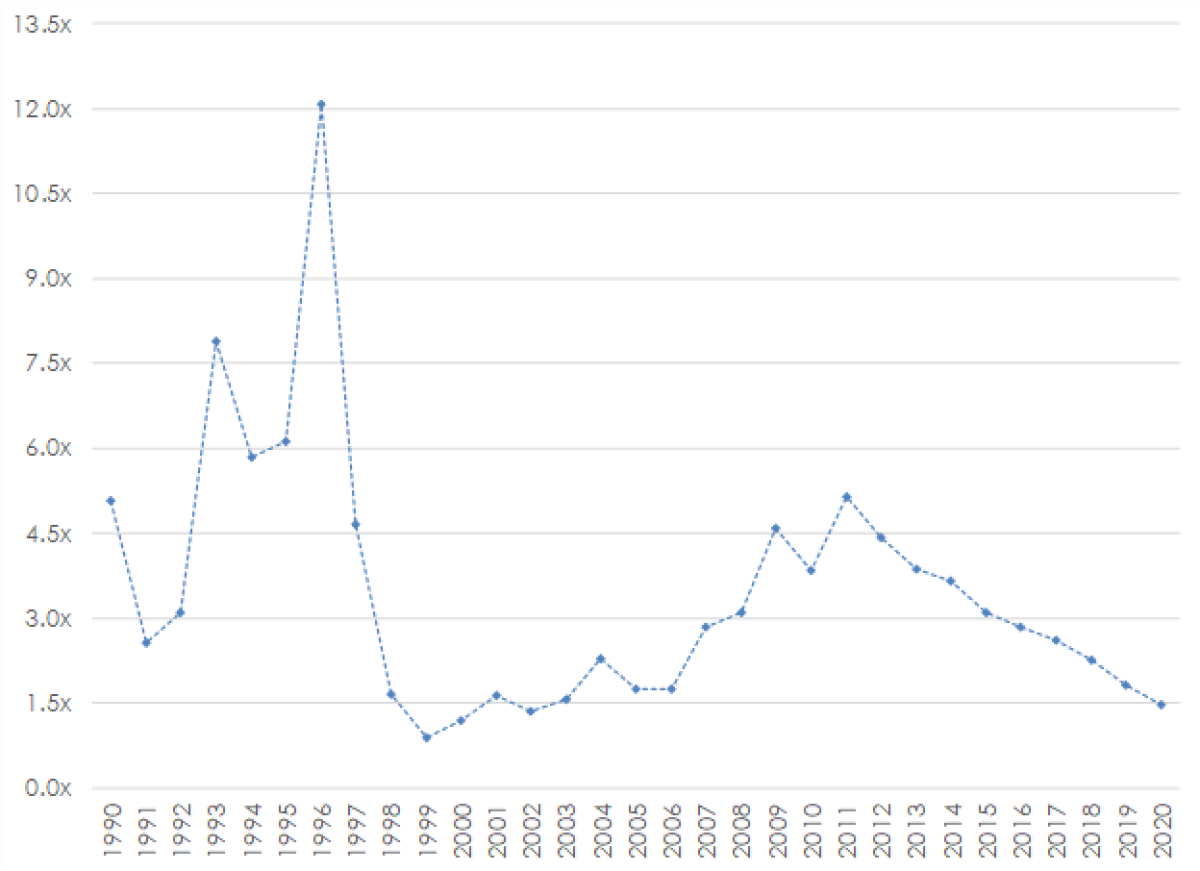Authored by Steven Novakovic, CFA, CAIA, Managing Director, CAIA Curriculum
One thing alternatives investors can count on is market cycles. Whether driven by macroeconomic factors, political factors, investor sentiment, supply and demand shifts, adjusting capital market expectations, or any other of a variety of factors, alternative investment strategies will have ups and downs and booms and busts.
Perhaps one of the earliest and most illustrative (and extreme) examples of this is the dot com boom and bust. In just three years, from 1996 to 1999, first quartile early-stage Venture Capital (VC) fund performance fell from a net multiple 12.1x to 0.9x.[i] That’s no typo, indeed, in 1996, first quartile VC funds generated a net multiple of 12.1x! Keep in mind that the bubble did not burst until 2000/2001. Meaning the mid-90s vintage funds were able to benefit from investing at a time of reasonable valuations and generate substantial exists during the excess and boom in the following years:
1st Quartile Early-Stage VC Fund Net TVPI by Vintage Year: 1990 – 2020

Source: Burgiss Group
Managers “unlucky” enough to raise funds later in the 90s had the misfortune of investing at high valuations and enduring a longer wait for IPOs and exits. There were over 1,600 IPOs in the US from 1997 through 2000. The next three years saw a tenth of that activity combined.[ii]
This brings to mind a fun trivia question (you can find the answer at the end)! How many years did it take for aggregate IPO activity to match the four-year stretch from 1997 to 2000?
Certainly, VC has experienced additional cycles since the dot com era, but none as big or wild as that one. Today, VC investors are in the midst of a down cycle, after an exciting 2020 and 2021. In fact, 2021 saw the most US IPOs since 2000. Then came 2022, which saw the fewest IPOs since 2008. 2023 fared little better, and VC investors are left wondering when will the good times roll once again?
Based on recent analysis by the Institute for Private Capital, investors should not expect the boom times to return soon, at least not for the first half of 2024. And conditions are just as bad in Europe—if misery truly does love company. Is there a silver lining in all this doom and gloom? The tough conditions certainly don’t bode well for investments made over the last three to five years.
But what about investments made today?
As many seasoned alts investors well know, some of the best vintages can come during the most challenging environments. For VC, 2008 and 2009 were the best performing vintage years since 1999. In fact, 2009 was the second-best performing vintage of the last 25 years (as measured by 1st quartile fund performance). A variety of factors play into the reasons behind this, but without question, one of the most important factors is entry valuation.
Whether you are looking at the US or Europe, valuations are coming back to earth, and the non-traditional participants that contributed to the excess are leaving the market. At times like this, it can feel hard to be contrarian and allocate capital to a strategy that is struggling to generate any sense of hope or optimism. While it is never a good idea to attempt to call the bottom of a cycle, what we can say definitively is that we are far away from the top!
At a time like this, what other steps can investors take to help boost returns and add value to their portfolio? One place to start—take a deep dive into all things Venture Capital and read a book by the experts such as Secrets of Sand Hill Road by Scott Kupor, who incidentally was an industry guest of the inaugural episode for the Capital Decanted podcast! Or check out this recent analysis showing LPs should seek greater diversity in VC management teams. To get to the heart of the matter “each 10 percentage point increase in representation of women is associated with a 1.3 percentage points increase in IRR.” Not bad!
Here's to hoping 2024 is the beginning of an up cycle for VC. We’ll be sure to check back in 5 years and share the results.
Bonus content. For those of you interested in a deeper dive into the outlook for VC, the following are handful of 2024 VC outlooks that have come across our desks. Enjoy!
- Allocate VC Industry Outlook
- JP Morgan Growth Equity Outlook
- Pitchbook European VC Predictions, Pitchbook VC Fundraising Predictions, and Pitchbook US VC Outlook
- Asia VC Outlook
- Seed Investing in 2024
- 14 VC Predictions from Forbes
Trivia Answer: It took 15 years (from 2001 through 2015) for total aggregate IPOs to surpass the 1,600+ that took place from 1997 to 2000.
[i] Performance data from Burgiss Group
[ii] IPO data from Ritter (2023) IPOs: Updated Statistics. University of Florida



